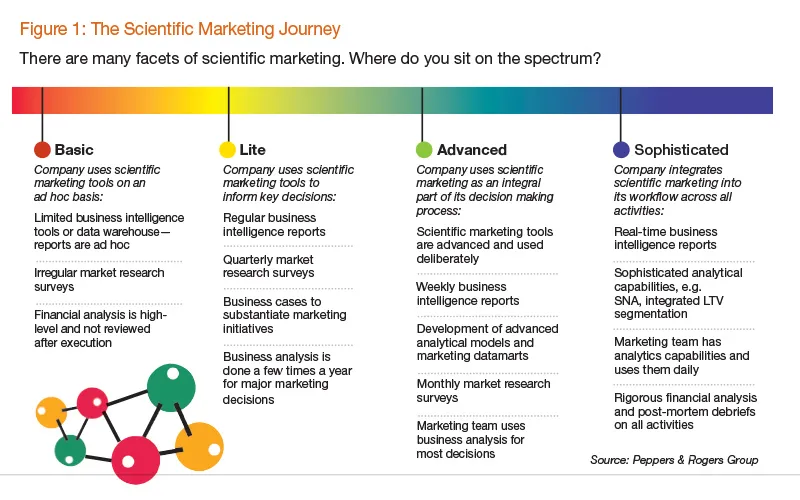If you knew with 100 percent certainty that an investment of $100 would give you an ROI of 200 percent, would you make it? If you could clearly identify the cause and effect of your successful marketing activities, would you do it? Surprisingly, the answer to both questions for many marketing departments is no.
Few marketing leaders take a deliberate and systematic approach to plan, execute, and review the success of their marketing activities. Even fewer truly understand the underlying reasons for their successes or failures. Management by "gut feel," prior experience, or pure luck is still widespread among marketers. So why are they surprised when they must fight to win the support of the CEO and other senior management?
In a recent survey of 1,200 CEOs globally by the Fournaise Marketing Group, a shocking 80 percent of CEOs admit they do not really trust and are not very impressed by the work done by marketers. In comparison, 90 percent of the same CEOs do trust and value the opinion and the work of CFOs and CIOs. In the survey, 80 percent of CEOs believe marketers are too disconnected from the short-, medium- and long-term financial realities of the business.
More than ever before, today's marketing chiefs influence critical parts of the business, including product research and development, sales, customer experience, etc. Yet while companies invest in new capabilities for manufacturing, procurement, finance, and even HR, rarely do companies make significant investments in developing and institutionalizing their marketing capabilities. Marketers must deliver the art of the craft with the science to back it up. Many know this, but can't move beyond their marketing comfort zones to spur innovation.
Break out the slide rules
As a marketer, chances are you are (or you wish you were) advertising or marketing around the hit television sitcom The Big Bang Theory. The show revolves around the misadventures of four scientist friends. So why not take a lesson from the nerdiest of the bunch—Dr. Sheldon Cooper—and let science drive your decisions?
Scientific marketing is the systematic study and application of marketing activities and their impact on customer behaviors. In other words, scientific marketing is a more thoughtful approach to marketing. It is learning from the past, dissecting marketing successes and failures into its individual components, and taking advantage of the insights gained from them. It might not be as exciting and fun as traditional marketing, but if done well, it resonates with marketers and achieves measurable results in ways traditional marketing can't.
Ideally, companies should document everything they learn as they work on different initiatives, then institutionalize the successful methods they derive. Other disciplines such as finance, IT, manufacturing, and others tend to follow very structured and deliberate approaches to their operations. This has given birth to many rigorous modus operandi (e.g. TQM, ISO, etc.). But marketing departments have yet to embrace that level of sophistication and standardization.
A scientific approach allows marketing initiatives to be repeatable, predictable, consistent, and institutional. Those attributes may not be "sexy," but they are extremely important to a company's bottom line. By being repeatable, marketers can leverage a past approach to duplicate the success of a new product launch, pricing strategy, or promotion. A predictable initiative means that the expected returns become more reliable. Delivering a consistent product, brand, and customer experience is what drives customers to choose and stay with companies like Starbucks, Amazon.com, Emirates, Bose, Apple, or BMW over competitors. And with institutional programs, companies become less dependent on any one person and can leverage a high level of institutional knowledge and practices with both old and new employees at any time.
The benefits of scientific marketing are evident in organizations such as Apple, which many predicted would disintegrate after the death of its charismatic leader, Steve Jobs. Yet, Apple has since fared well as Jobs successfully institutionalized a strong culture that follows a more rigorous and systematic approach in all areas, including marketing. The way Apple does business and makes key management decisions is explicitly documented in internal case studies and implicitly inculcated in employees to ensure Apple maintains its culture. There are certain things that define how Apple does business, e.g. simplicity, premium pricing, high-end branding, rare compromises on product quality, etc. The same could be said of other companies well-known for their disciplined approach to marketing, such as consumer goods giant Procter & Gamble.
Infusing scientific discipline into your marketing department
Scientific marketing does not mean that you should abandon the creative side of marketing for complete attention to data and analysis. And it shouldn't be a fight about which is better—the left-brained (analytical) or right-brained (creative) marketer. The new marketing world is about being "whole-brained," as some in the industry say. Scientific marketing adds some weight to the analytical side.
So what can marketers do to infuse science into the art of marketing? We break it down into three steps: define your overall strategies, enable scientific marketing philosophy and practice, and execute and track your plans.
Marketing chiefs need to clearly articulate what marketing activities they wish to enhance, then define the goals of this new approach. Not all activities lend themselves to a scientific approach, so you must be realistic about your level of readiness and capabilities to embrace a different approach to marketing. Taking a company from 0 to 60 requires patience, organizational buy-in, and a clear strategy, accompanied by a plan and budget to achieve it. Some key activities to consider scientifically include:
- Product, service and customer experience development: We rarely see marketers take advantage of sophisticated methods to develop their value propositions. This is one of the weakest areas of today's typical marketing department where few marketers use tools such as integrated lifetime value (LTV) segmentation analytics to develop better products.
- Pricing: This area has always followed a more rigorous exercise as it requires careful consideration of consumer price sensitivities, competitive pricing, and operational costs. Nonetheless, there are many good methods like integrated lifetime value customer segmentation, economic price discrimination, or below-the-line (BTL) piloting that marketers can use more consistently to refine product pricing.
- Marketing communications: With the advent of digital advertising, media planning in digital is where we frequently find application of scientific marketing, e.g. BTL revenue stimulation in the telecommunications business, or SEM and SEO to drive higher clicks on Google and Facebook advertisements.
- Sales and distribution: Discipline is lacking in this area. For example, channel optimization using customer segmentation and sales data is a very simple and powerful, yet underutilized method. If a company wants to attract more high-value and loyal customers, it should provide more incentives to the channel that drives those types of customers.
Overcoming barriers to enablement
Sure, being more scientific sounds good in theory, but putting it into practice can be a challenge. When it comes to enabling scientific marketing, roadblocks include organizational challenges, the willingness of marketers to change, the expanded skills required, tools and processes, limited training resources, and analytical and business intelligence tools. Some recommendations around each of these roadblocks include:
- Organization: Each marketing function must have an owner empowered to drive change.
Organizations need to be designed around scientific marketing work flows to function coherently. - People: Marketers need to have the willingness to become more scientific in their approach, as well as have new skill sets to enable it. The most sophisticated scientific marketing methods require skills not easily found among business school graduates. A real-time geo-marketing analytical model might require a master's degree in Applied Statistics, for example. Look outside traditional disciplines for experts.
- Processes: Marketers need to know when to use scientific methods for optimal results. For instance, when is it ideal to use primary market research surveys and focus group sessions? Learn from each endeavor, and share those results with others to inform future processes.
- Information: As we have previously written in this journal, the lack of timely, actionable information is oftentimes the most basic hurdle. Organizations need to invest in tools to make information available to those who need it, analyze it effectively to guide decision-making, and track relevant customer KPIs.
The benefits are well documented —a 2011 research study from MIT, Strength in Numbers: How Does Data-Driven Decision-making Affect Firm Performance, shows productivity improvements in the order of 5 to 6 percent resulting from adoption of data-driven decision making.
- Training: Does your marketing organization offer formal and informal training to ensure all marketing staff have the same vocabulary, use the same tools, and have the same understanding of how to do marketing "the right way" in your organization? Don't forget to provide marketers with the knowledge to succeed.
- Culture: For scientific marketing to become ingrained in a company's DNA, marketing chiefs must lead by example. At its best, we have seen some of the world's leading marketing organizations coin their own marketing vocabulary, understood only by the truly initiated. Get everyone on the same page, working toward the same goals.
Execution
Once a strategy has been devised, it comes time to execute against a clear plan and track progress. Many scientific marketing efforts fail at this stage as many organizations lack the full commitment and resources to embark on what can be a multi-year journey. In some instances, it might make sense to outsource select functions in the medium-term and eventually bring them back in-house once the expertise has been developed, e.g., analytics, pricing, and media planning are activities that can easily be outsourced to get scientific marketing power in weeks rather than years.
Tying science to art
Naturally, not everything can be reduced to numbers or a rational methodology that always produces black and white results. Unlike manufacturing, many marketing functions require human input that cannot be standardized. For example, a creative brief to an advertising agency, a product review with an R&D team, or the insights coming out of a focus group interview all have elements that require interpretation. Here is where experience, gut feel, and just pure instincts of an effective marketer come into play. But scientific marketing alongside these activities can provide a more rational framework and guidelines to produce more consistent outcomes.
The scientific approach to marketing is not just a concept. It's already happening at the world's leading companies. CEOs are looking for performance metrics, resources are tight, and timing is everything. The more precise marketing tactics and strategy, the higher the likelihood for success. To once again refer to Sheldon Cooper in The Big Bang Theory, "Don't you think if I were wrong, I'd know it?" With a scientific approach, the answer is yes.


















